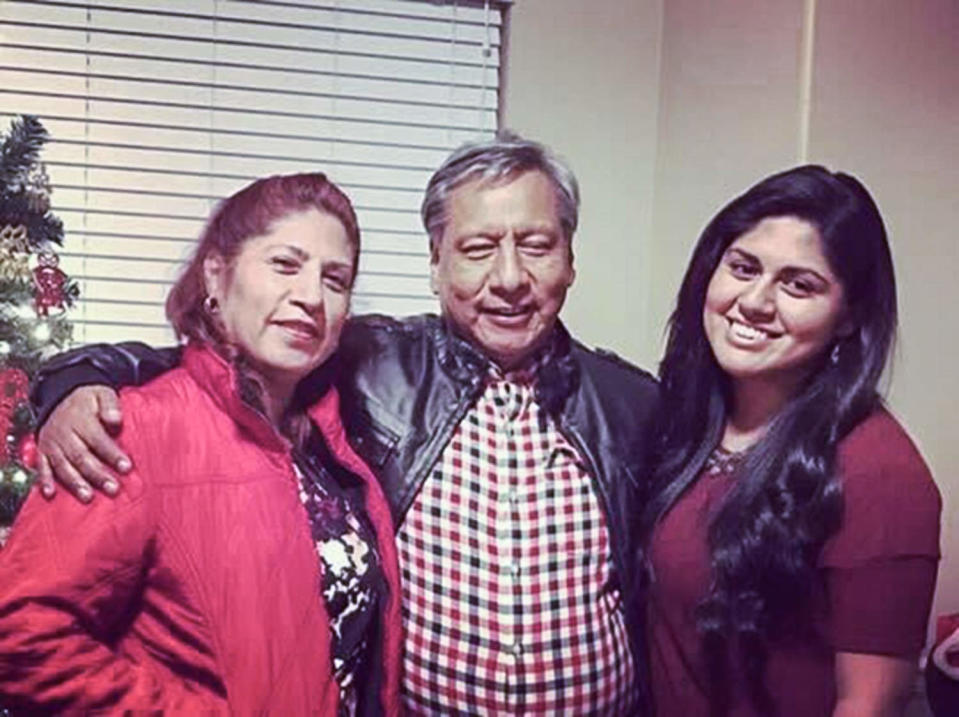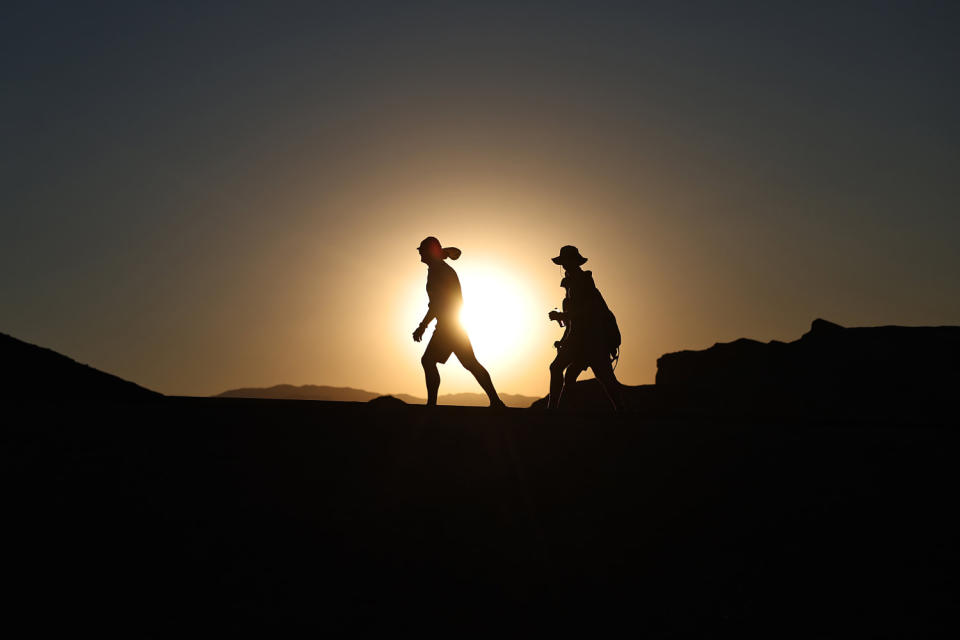Belyruth Ordóñez was an avid walker.
For the past few summers, the 30-year-old and her parents traveled to parks around Utah, where they lived, to hit the trails together.
But on Saturday, the heat was too intense and tragedy struck. Temperatures in Utah’s Snow Canyon State Park climbed above 100 degrees F, and Ordónez was found dead there, apparently overwhelmed by the extreme conditions.
Her parents, Humbelina and Dario Ordóñez, were found next to her and both were hospitalized with heat exhaustion. They remain in critical condition.
“They don’t know their daughter died yet,” said Melanie Penaloza, Belyruth’s close friend.
“It’s scary to know that she died walking, because that’s what she loved to do,” Penaloza said.

Ordóñez’s death is one of four heat-related deaths reported in state and national parks already this month. The day before she was found, authorities found the bodies of Albino Herrera Espinoza, 52, and his daughter Beatriz Herrera, 23, at Canyonlands National Park in Utah.
The Wisconsin resident got lost hiking the Syncline Loop Trail and ran out of water, according to the San Juan County Sheriff’s office. Relatives of the Herreras could not be reached for comment.
Earlier this month, six motorcyclists from Germany were overwhelmed by the heat at Death Valley National Park in California.
Other visitors found the group on July 6 and brought all but one man to the park’s visitor center. The man who remained, Jurgen Fink, 61, was later pronounced dead by park officials, according to park spokeswoman Abby Wines.
One of the motorcyclists had to be taken by ambulance to Desert View Hospital, more than 60 miles away. Wines said it was too dangerous for rescue helicopters to fly that day because of the extreme temperatures, which reached 128 degrees.
And three deaths at Grand Canyon National Park in the past five weeks are under investigation, with the heat considered a likely factor.
Hiking trip for ‘family bonding’
Heat kills more people than any other form of extreme weather, and is becoming more deadly in parks and elsewhere as heat waves become more frequent and severe due to climate change. Parts of the South West experienced the warmest June on record. Maricopa County, Arizona, where Phoenix is, has already raised more than 300 deaths suspected to be related to heat this year.
Although heat deaths are reported on public land every year — 77 deaths from hyperthermia were recorded in national parks from 2007 to 2023, according to an NBC News analysis — the numbers appear to be trending above average this early summer.
“It’s a sign that we’re going to see more deaths and more people suffering in their daily lives with the heat,” said Floris Wardenaar, an assistant professor of nutrition at the College of Health Solutions at Arizona State University and an expert on south exposure and recreation.
The early summer heat, in particular, can take people by surprise, he said. “They haven’t adapted to it yet.”
The National Park Service does not close parks when extreme temperatures hit, instead focusing on broadcast forecasts, alerting visitors to weather hazards and encouraging them to dial back plans, such as hiking during cooler parts of the day.
“Our position is to empower visitors to make the right decisions when planning their trip and choose the right activity based on skill and experience,” said Cynthia Hernandez, spokeswoman for the National Park Service. “Park managers can close a specific area, like a trail that doesn’t have much shade, or post more notices.”
“The vast majority of people who visit parks are able to make it home safely, and part of the excitement for many park visitors is the adventure,” Hernandez added.


However, as record high temperatures hit fields, the margin of safety can be quite thin.
Marlon Olaya, a friend of the Ordóñezes, said the close-knit family from Peru lived in Orem, Utah, and were members of the Church of Jesus Christ of Latter-day Saints. The family had hiked together at Snow Canyon before, he said.
“It’s heartbreaking,” Olaya said. “The intention was to have a family bonding moment.”
Olaya described Belyruth as “humble and kind.”
“She was always a very loving person,” he said. “It’s very sad to see someone like that go.”
As an only child, Belyruth loved her parents, Olaya said: “She always became clear – her parents were her heroes.”
Olaya said both parents had passed out by Wednesday.
Both have hazy memories, Penaloza said, and Dario Ordóñez is on dialysis with struggling kidneys.
“We are praying so hard that they will be safe,” she said. “They are confused about the past and the present, and don’t remember exactly what happened.”
‘It’s going to be hotter on the track than you’d expect’
An analysis of temperatures from July 5 to 7 in the western United States indicates that temperatures were more than 7 degrees F higher than past heat waves. The research, carried out by scientists with Climameter, found that both climate change and natural variability played a role in intensifying the heat.
On park trails, conditions are often very different between the conditions and the estimates on weather applications, the Warden said.
“It’s probably going to be hotter on the road than you’d expect,” he said. “We’re doing a study with different surfaces here in Arizona and especially when there’s a lot of rock and not a lot of shade, the radiation from the rock can go up during the day so you’re going to generate a lot more heat in your body. “
That may have been a factor in the three deaths at Grand Canyon National Park.
Two of the hikers — a 41-year-old man found unresponsive on the park’s Bright Angel trail in June, and a 50-year-old Texas man found near the same trail on July 7 — have not been identified. public.
The third was Scott Sims, 69, of Austin, Texas, who was found “semi-conscious” on the River Trail on June 29, according to the park service.
In the summer, the temperature on exposed parts of that trail can reach over 120 degrees in the shade.
A spokesperson for Grand Canyon National Park said it was under an excessive heat warning until July 12. In a statement, the park service said that visitors are advised to refrain from walking from 10 am to 4 pm
“If you’re hot, cool off by getting wet in puddles and at water stations. Heed warnings and signs in the canyon,” the statement said. “Always pack a means of water filtration. If you hear warnings, you can have a pleasant walk instead of a life-threatening incident.”
The Warden recommended that visitors should carry 32 ounces of water for every hour of planned walking in hot conditions, and turn around before consuming half of their water.
Relatives of Sims could not be reached for comment, but a woman named Jessica Ryan identified Sims as her uncle in a Facebook post and said she had been hiking with him before his death.
“There are no words for the events that happened and the emotions we are feeling right now. It’s just what you see in movies. The most beautiful places are unforgiving. Be ready. Don’t ignore nature,” she wrote.
This article was originally published on NBCNews.com